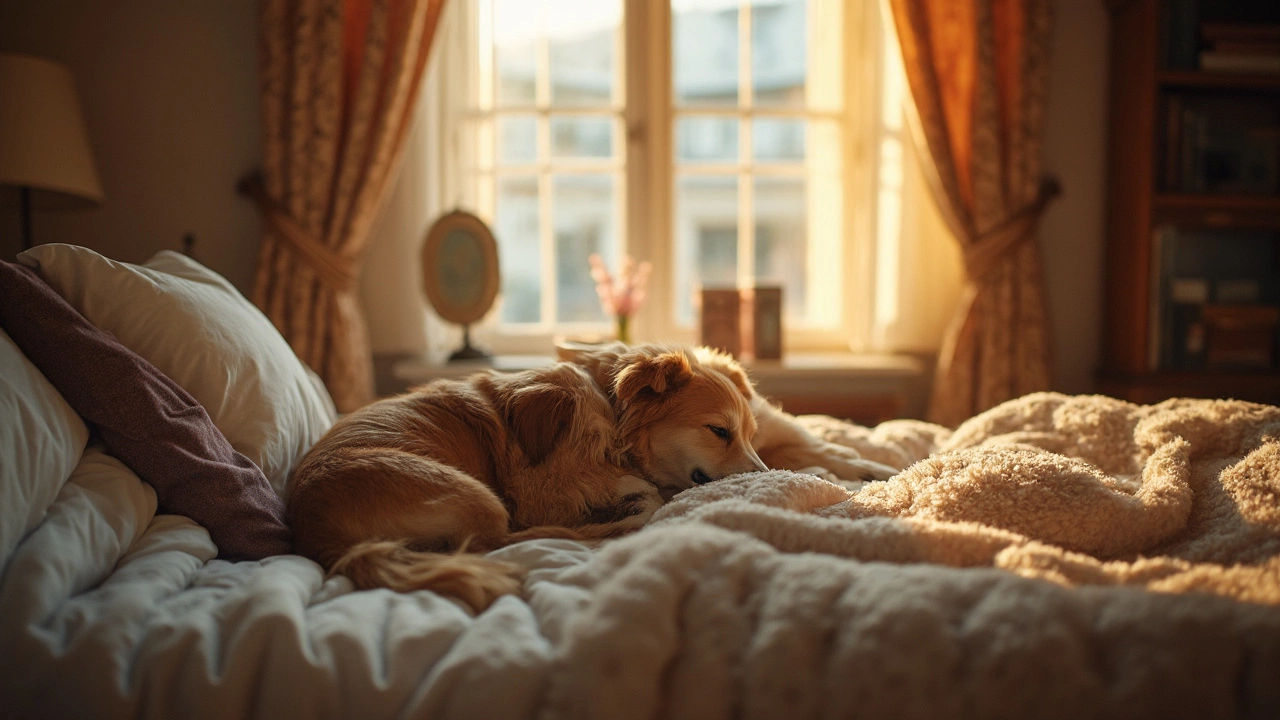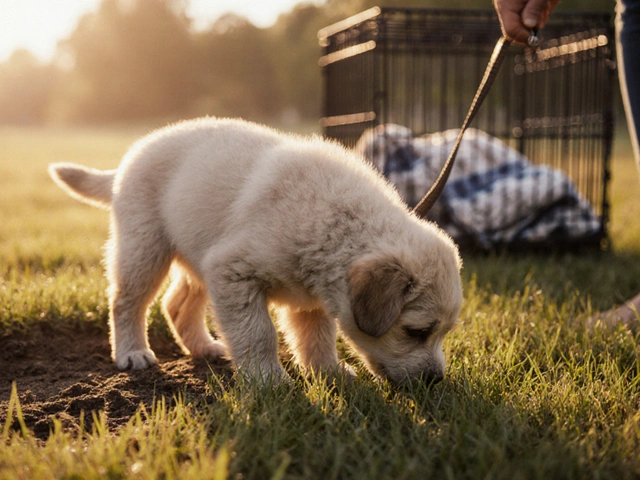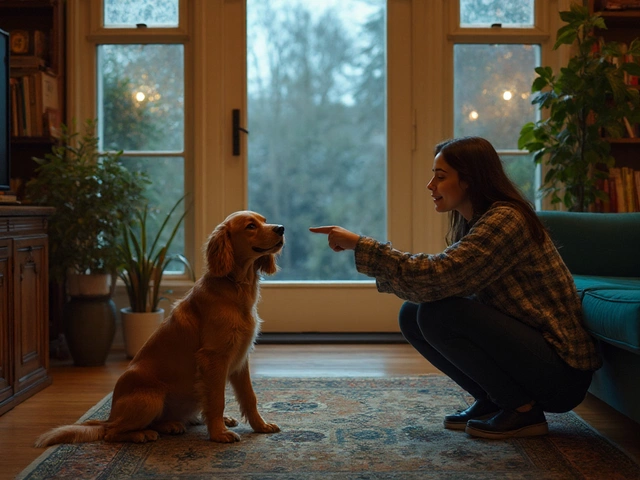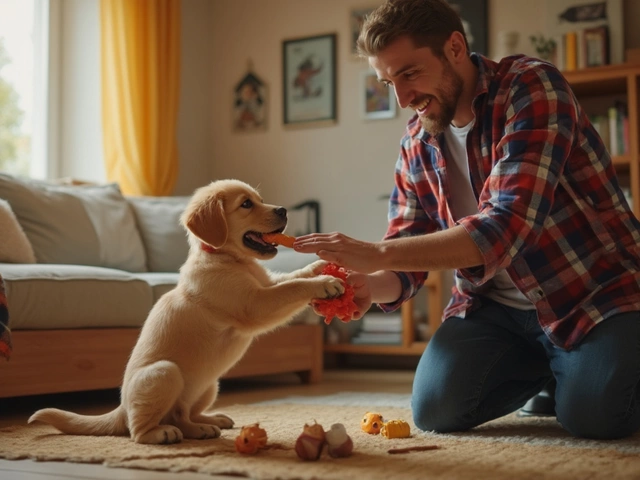If you’re reading this in bed with a warm ball of fur curled at your feet, you’re not alone. About half of all dog owners admit their pup sleeps in their bed at least sometimes. It might be cozy, but is it really a smart move—for you and for your dog?
This decision goes way beyond just comfort. You’ve got hygiene, interrupted sleep, and even your pup’s behavior to think about. It’s not just about whose snoring is louder. Ever wake up with dog hair in your mouth? Yep, it’s a thing. Or maybe your dog is the one struggling to find a comfy spot, turning your queen-sized bed into a wrestling ring.
Before you let your dog claim that prime pillow real estate, it’s good to know what you’re actually signing up for. Let’s see what happens both for us—humans—and our dogs, when that last bedtime yawn turns into a nightly tradition of “move over, buddy.”
- Why Dogs Love Human Beds
- What Happens When You Share Your Bed
- Pros and Cons for You and Your Dog
- Setting Boundaries and Alternatives
Why Dogs Love Human Beds
Let’s be real—your bed is probably the comfiest spot in the house, and your dog totally knows it. But the pull toward your bed isn’t just about soft sheets.
First up, dogs are pack animals. Back when their ancestors roamed wild, sleeping close to each other meant warmth and safety. That instinct’s still wired deep, so when your pup curls up with you, they’re looking for that same comfort and connection. Sleeping in your bed puts them next to their favorite human. That’s legit dog happiness right there.
Another thing: your scent. For dogs, who have a super-powered sense of smell, sleeping on your bed surrounds them in your scent. It makes them feel safe and relaxed, which can be especially important for a dog that deals with anxiety or gets stressed out when you leave the house.
Believe it or not, dog beds just don’t compare in the eyes (and nose) of most pups. Your bed smells more like you, it’s warmer, and it’s usually in the busiest room at night—where stuff happens. Dogs love being part of the action, even when everyone’s asleep.
If you’ve noticed your pooch scratching at the bedding or circling before flopping down, that’s normal. It’s how they turn your bed into a personal nest, just like their ancestors did outdoors. So, if your dog chooses your bed over a fancy dog bed, it’s less about ignoring that orthopedic mattress you bought and more about instinct and bonding.
| Reason | Why Dogs Care |
|---|---|
| Packed-in warmth | Staying warm and cozy next to humans mimics natural pack behavior |
| Human scent | Reduces stress, boosts feelings of security |
| Social bonding | Sleeping together strengthens your connection |
| Comfort | Your bed’s softness beats most dog beds |
So next time your dog sprints to your side of the bed, just remember: they’re not trying to take over the world—they just want to be near you.
What Happens When You Share Your Bed
Letting your dog hop onto your bed changes more than just your sleep position. The main thing folks notice right away? The quality of their own sleep. Dogs, even when they're zonked out, move around at night. They scratch, sigh, twitch—and sometimes full-on kick. According to the Mayo Clinic, about 20% of pet owners report their sleep with dog is interrupted more than when they sleep alone. Ever tried to get back to sleep after a 3 a.m. nose in your ear?
There’s also the issue of hygiene. Unless you’re scrubbing your dog daily (which isn’t even healthy for their skin and coat), some dirt, pollen, and definitely fur will end up in your sheets. If you or your kids have allergies, this can mean waking up stuffy and itchy. Fleas and ticks? It’s rare, but it’s been known to happen, especially if your dog’s flea medication isn’t up to date.
Another thing a lot of people don’t realize: Your dog might get used to this “togetherness” and suddenly act stressed or anxious if you want them to sleep elsewhere. Not all dogs, but some—especially rescue pups or those with separation issues—can panic when you close the bedroom door.
On the flip side, some people feel a real bond when their pup is close at night. Dogs with a good routine thrive on connection, and for anxious humans, their furry friend can have a calming effect. Got kids? They might sleep better knowing their loyal four-legged pal is just a pillow away.
It’s not just about comfort or furriness, though. Here’s a quick breakdown of what usually changes when you and your dog on bed become bedmates:
- More interrupted sleep (from doggy dreams, movement, or snoring)
- Possible allergy flare-ups, even in non-allergic folks
- Increased pet attachment, which can make later transition to a dog bed tough
- Messier sheets—think mud, fur, and sometimes even accidents
- Physical comfort for both, especially in colder months
Here’s some real-life data to give you a better picture:
| Experience | % of Dog Owners Reporting |
|---|---|
| Better emotional comfort | 42% |
| Interrupted sleep | 23% |
| Increased allergies | 11% |
| Dogs developing attachment | 18% |
If you value your dog hygiene or crave space at night, a dedicated dog bed on the floor might be a smarter move. But if doggy cuddles make your day, you’ll want to weigh that against the downsides. It’s a trade-off, not a universal rule.
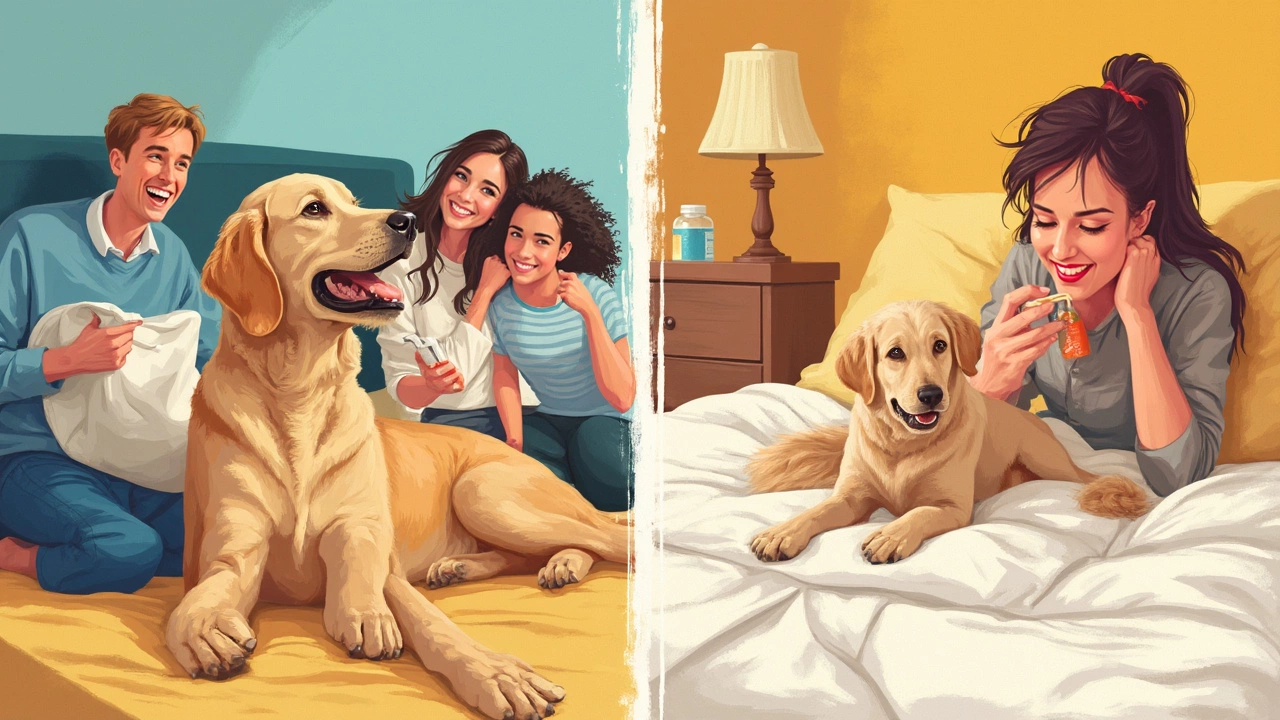
Pros and Cons for You and Your Dog
Lying in bed next to your canine feels great, but it's not all cuddles and comfort. If you’re thinking about letting your dog on bed, here’s what’s really at stake for both sides.
Pros for Humans:
- Comfort and Bonding: A lot of people say their stress levels drop when their dog sleeps next to them. That warm lump by your feet? Science backs you up—sharing a bed sometimes raises oxytocin, the feel-good hormone.
- Safety: Even a small dog can make you feel safer at night, especially if you live alone or get nervous at weird noises. Dogs are usually light sleepers and will bark if something’s up.
- Warmth: Let’s be honest—nothing beats a dog for a furry hot water bottle on a cold night.
Cons for Humans:
- Sleep Disruption: Around 20% of pet owners say that their sleep with dog gets interrupted by movements, scratching, or snoring. Light sleepers beware.
- Allergies & Hygiene: Even if your dog is clean, fur, dirt, and dander find their way into your sheets. If you have allergies or asthma, this could make your symptoms worse.
- Relationship Strain: Sometimes your pup ends up right between you and your partner. Turns out, a jealous dog can make things awkward—literally and figuratively.
| Human Benefit | Human Drawback |
|---|---|
| Reduced stress, increased bonding | Possible sleep disruption |
| Increased sense of safety | More allergens in bedding |
| Extra warmth | Potential for relationship tension |
Pros for Dogs:
- Stronger Bond: Dogs are social and love being close to their people. Letting your dog up your bed keeps them feeling included.
- Comfort: Your bed is probably softer and warmer than most dog beds. Older or anxious dogs especially love this upgrade.
- Security: Timid dogs may sleep better near you, especially during storms or fireworks.
Cons for Dogs:
- Behavioral Issues: Some dogs get possessive about the bed, which can lead to guarding or snapping. It can muddle their sense of boundaries.
- Inconsistent Rules: If your dog sometimes gets to sleep with you and sometimes doesn’t, it may confuse them or stress them out.
- Disrupted Sleep: Just like humans, dogs can get kicked or pushed off the bed at night, leading to broken sleep or even minor pain for older pups.
Bottom line: Weigh the pros and cons for your lifestyle and your dog’s personality. There’s no one right answer, and some folks even compromise by starting the night together, then moving the dog to their own dog bed after a while. No shame in doing what works best for your crew.
Setting Boundaries and Alternatives
If sharing your bed with your pup isn’t working out, or if you want to make sure your dog bed gets some use, setting up ground rules is key. Dogs actually feel safe and less anxious with clear routines. If you stick to them, you’ll have a more peaceful household at night—for both you and your dog.
Here’s the thing: deciding where your dog sleeps is about what works for your family, and sometimes that means a few changes. If your dog is used to jumping in bed as soon as you pull back the covers, start by teaching them a simple command, like “off” or “bed.” Consistency is everything. Every family member—kids included—has to be on board. Trust me, Gideon used to sneak our dog up when I wasn’t looking. Dogs are smart and will test where the rules bend.
- Stick to a bedtime routine: Walk your dog before bed, then guide them straight to their dog bed. A cozy blanket or a worn t-shirt with your scent makes the spot irresistible.
- Use positive reinforcement: Every time your dog stays in their own bed, reward with a treat or extra praise. Skip punishment—it just confuses them.
- Make the dog bed special: Comfy bedding, a favorite chew toy, or even a heating pad (set on low) can make their own bed feel like a haven.
- Block access if needed: Shut the bedroom door or use a gate. Out of sight, out of mind works better than a drawn-out nightly standoff.
Want numbers? Here’s what one pet survey found about where dogs really sleep:
| Sleeping Spot | Percent of Dogs |
|---|---|
| Owner’s Bed | 45% |
| Dog Bed in Bedroom | 35% |
| Dog Bed in Another Room | 15% |
| Crate/Kennel | 5% |
If you want a compromise, try letting your pup sleep in the bedroom—but not on the bed. Setting up a quality dog bed right by your side hits the sweet spot for closeness without snoring in your ear. Dogs love being near their humans. If that’s too much, start by letting them nap in the bedroom during the day to get used to their new sleep spot.
If your dog’s having a tough time with new rules, double-check if their dog bed is comfy enough or if there’s something about their old routine they miss—like a late-night belly rub or the warmth of your feet. Adjust slowly and give lots of encouragement. Before long, both you and your furry roommate might just wake up more rested than ever.

